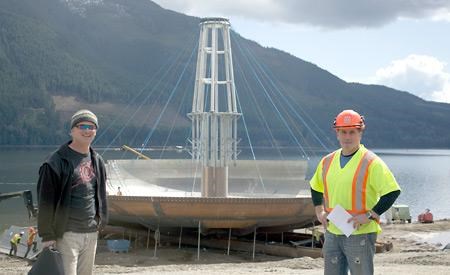An operation which started as a family business in the early 1970s has become one of the largest quality suppliers of steelhead salmon in the country.
West Coast Fish Culture (WCFC) at Lois Lake had a focus on sustainability and efficiency that was well ahead of its time. This directive, together with an innovative approach to research and development, have led the company to domination of the Canadian market. WCFC was recently acquired by AgriMarine Industries.
The company retains the WCFC name while operating under the larger umbrella. With the infusion of investment and technology, WCFC is poised for progress.
Its success earned the farm the United Nations Food and Agriculture Organization’s Code of Conduct for Responsible Fisheries, and an Ocean Wise™ stamp of approval.
New perspectives and new proprietary technology are products of an ongoing foundation of progressive management and operations.
Ryk Mooring, hatchery manager at the farm, said WCFC is a first-generation farm with the fourth generation currently at the helm. “On average the farm raises 1,000,000 steelhead every year,” Mooring said. “This year that number is expected to jump to 1,700,000. The hatchery uses its own recirculation technology for incubation and fry rearing systems. The water drawn into the hatchery is heated in an oil-burner system also devised by staff and management.”
Mooring explained that using fish oil to heat the water was largely a measure to further reduce the farm’s carbon footprint. “Only water of the highest quality is used at each stage in the operation,” Mooring said. “This is achieved by using drum filters, bio filters, ultraviolet sterilization for pathogen control, and ozone filtration—all systems that were designed and engineered by staff.”
As he peered into one of six large reservoirs, he added “There are 70,000 immature fish at various stages of their early life cycle in each of the circulating tanks. We hire 10 students through the summer and winter breaks to help with injecting each one of these fish to protect against disease. Every fish is put to sleep and injected. And it’s all done by hand.”
Mooring said that a big part of the farm’s overall success through the years is due to management encouraging fresh thinking and problem solving among staff. “Team members are encouraged to think outside the box. They are the ones working closest with the systems we use. They are going to understand and have workable ideas how to overcome challenges as they arise. It’s about being in a place where, if you have an idea, you’re encouraged to just go for it.”
It’s a brand of progressive thinking that has allowed the company to engineer and develop its own oxygen generation system, its own incoming and outgoing filtration system and its own method of generating ozone.
“We try wherever possible to use organic processes,” Mooring explained surveying a man-made stretch of wetland marsh that serves as a final natural filtration process. “We look to old technologies—as far back as ancient Egypt, and technology and wisdom from early Chinese agrarian cultures—to use in some of what we do. As the water drains through the marsh, any micro-impurities that remain are removed before the recycled water is returned to the lake. We are constantly testing to make sure nothing gets past our filtration processes.”
Farm manager Bill Vandervert was instrumental in developing the first pescalators—a fish transport device based upon the concept of Archimedes’ screw. Pescalators are used to lift fish from ponds, raceways and net pens for grading, vaccinating, sorting and harvesting. Vandervert was also instrumental in developing WCFC’s Simply Fish fertilizer, which now has organic certification through PRO Cert and the US Department of Agriculture.
“We use everything that comes from the processing plant, nothing is wasted,” said Mooring, pointing to a stack of reinforced steel crates. “Farmers love it. Gardeners love it. Demand in the marketplace has been solid from the start.”
Jim Sepkowski, research and development manager at the farm, has been around since 1990. He’s a full-time diver managing underwater inspections of the containment systems and he directs crews in day-to-day farming operations.
“We’re continually exploring ways to improve the process,” Sepkowski said. “This means having eyes open at all times. The new containment system we’re working on now is engineered to transfer wave energy through the structure rather than buck up against it, potentially causing problems.” He nodded toward a massive structure under construction on the shoreline. “They don’t look anywhere as massive once they’re in the water. Just like an iceberg, you only see a small percentage when they are submerged.”
Sepkowski acknowledges the teamwork that moves the company along.“We have an excellent team here,” he said. “The good chemistry on the worksite goes a long way toward staying efficient and effective.”
The decision to purchase the company was a strategic move to stay on the leading edge of a fast-growing industry, according to Rob Walker, AgriMarine president. “It was an exciting opportunity for us. The team at WCFC knows their business inside and out. This made the transition easy.”
Walker explained that new advancements in brood stock selection, and intensive research in feed development, have contributed to the bottom line.
“Old wood walkways and early net systems have been replaced with the steel cages that are built to last 10 to 15 years,” he said. “Knotless nets resist breakage and fraying. This reduces potential harm to fish, making for a better end result.”
Of the world picture, Walker said that a recent blossoming of competition in Norway has provided some pressure to move forward. “We’re ahead of the pack, but the gap is narrowing. When the Norwegians decide to do something they do it big and they do it fast. As we dream big dreams here, there are big opportunities coming in the aquaculture industry. We have the infrastructure in place to take advantage when they do.”



